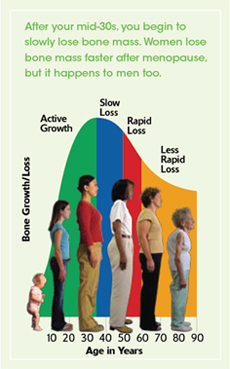What you know about your bones
Bones support your body and allow you to move. They protect your brain, heart, and other organs from injury.
Bone is a living, growing tissue. It is made mostly of two materials: collagen (KOL-uh-juhn), a protein that provides a soft framework, and calcium (KAL-see-uhm), a mineral that adds strength and hardness. This combination makes bone strong and flexible enough to hold up under stress.
Bone releases calcium and other minerals into the body when you need them for other uses.
Think of your bones as a “bank” where you “deposit” and “withdraw” bone tissue.
How bones grow
Think of your bones as a “bank” where you “deposit” and “withdraw” bone tissue. During your childhood and teenage years, new bone is added (or deposited) to the skeleton faster than old bone is removed (or withdrawn). As a result, your bones become larger, heavier, and denser.
For most people, bone formation continues at a faster pace than removal until sometime after age 20. After age 30, bone withdrawals can begin to go faster than deposits. If your bone deposits don’t keep up with withdrawals, you can get osteoporosis (ah-stee-oh-puh-ROH-sis) when you get older. Osteoporosis is a disease in which the bones become weak and more likely to break (fracture). People with osteoporosis most often break bones in the hip, spine, and wrist.
 What you need to do now—and why
What you need to do now—and why
If you want to be able to make “deposits” of bone tissue and reach your greatest possible peak bone mass, you need to get enough calcium, vitamin D (VAHY-tuh-min dee), and physical activity—important factors in building bone. If you want the strongest bones possible, the best time to build up your “account” is right now—during your childhood and teenage years.
Why should I care about this now?
You may know some older people (your grandparents, aunts or uncles, or friends of your family) who worry about their bones getting weak. You might even know someone who has trouble getting around because they have broken a bone because of osteoporosis. You might think that this is something that only older people need to worry about.
BUT—you can take action right now to help make sure that as you get older your bones are as healthy as they can be. Eating a balanced diet that includes calcium and vitamin D, getting plenty of physical activity, and having good health habits now can help keep your bones healthy for your whole life.
What if I don’t take care of my bones now?
If you don’t do the best you can now to make your bones strong, you might get osteoporosis when you are older.
Many people have osteoporosis and don’t even know it, since bone loss occurs over a long period of time, and it has no symptoms. The first sign of osteoporosis may be a broken bone in the spine, the hip, or the wrist. These fractures can be very painful and make it difficult for a person to walk or do the things they need to do every day.
Does osteoporosis happen to both men and women?
Both men and women can get osteoporosis, but women get it more often because of the changes in hormones that occur after menopause (MEN-uh-pawz). Also, women generally have less bone tissue than men. So, it’s especially important for girls to build up their bone “bank account” during their teenage years by exercising regularly and getting enough calcium and vitamin D.
What to do for strong bones—today and tomorrow
Osteoporosis is usually a disease of older people, but you can reduce your risk while you are young by eating the right foods and exercising regularly. Your bones need three major things to grow to their full peak mass: calcium,  vitamin D, and physical activity. Making sure you get enough when you are young pays off as you get older, so you can avoid looking stooped over (because of spine fractures) and keep doing the sports and other activities you love. For more information on a healthy diet, see www.choosemyplate.gov.
vitamin D, and physical activity. Making sure you get enough when you are young pays off as you get older, so you can avoid looking stooped over (because of spine fractures) and keep doing the sports and other activities you love. For more information on a healthy diet, see www.choosemyplate.gov.
For more information
National Institute of Arthritis and Musculoskeletal and Skin Diseases (NIAMS)
Information Clearinghouse
National Institutes of Health
1 AMS Circle
Bethesda, MD 20892-3675
Phone: 301-495-4484
Toll free: 877-22-NIAMS (877-226-4267)
For telecommunications support, dial 711
Fax: 301-718-6366
If you need more information about available resources in your language or another language, please visit our website or contact the NIAMS Information Clearinghouse at NIAMSinfo@mail.nih.gov.
This fact sheet was made for you by the National Institute of Arthritis and Musculoskeletal and Skin Diseases (NIAMS), a part of the U.S. Department of Health and Human Services’ National Institutes of Health. For more information about the NIAMS, call the information clearinghouse at 301-495-4484 or toll free at 877-22-NIAMS (226-4267) or visit the NIAMS website at www.niams.nih.gov.
NIH Publication No. 15-7577(B)
Original Article – https://www.niams.nih.gov/health-topics/kids/healthy-bones





